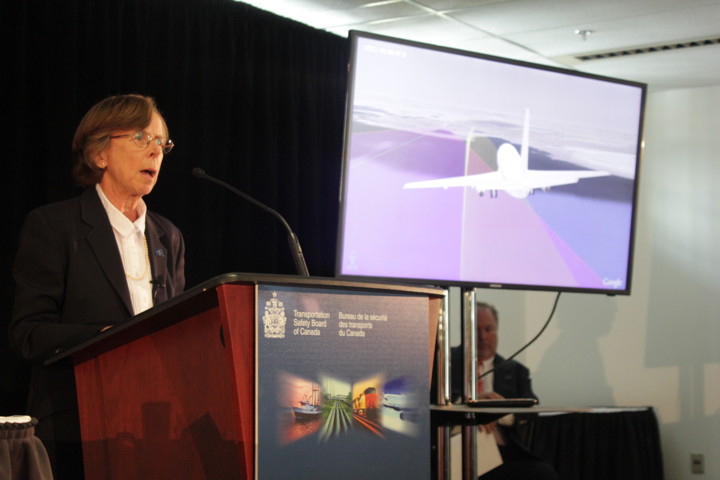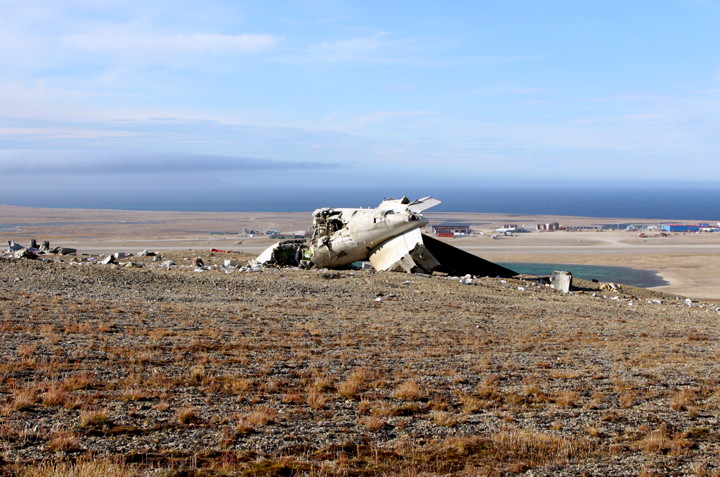TSB concerned about Transport Canada airline training standards
Pilots’ union says all stakeholders need to address safety issues

With the help of an animated film, Kathy Fox of the Transportation Safety Board explains how First Air Flight 6560 veered off its proper course — shown in purple — on a trajectory that eventually resulted in a hillside crash roughly a kilometre east of the Resolute Bay runway on Aug. 20, 2011. (PHOTO BY LISA GREGOIRE)

The Transportation Safety Board provided this photo to media March 25 showing a piece of the fuselage of First Air flight 6560 on the hill, looking west toward the Resolute Bay airport. The Boeing 737 had initial impact with the ground to the left of this photo. (PHOTO COURTESY OF TSB).
OTTAWA — Peter Black, a pilot for 35 years with First Air, says he is encouraged by the Transportation Safety Board’s recommendations stemming from its investigation into the 2011 First Air crash in Resolute Bay.
But he warns that it’s up to all stakeholders — from Transport Canada to operators — to ensure those recommendations are implemented in order to make flying safer for flight crews and passengers alike.
“All stakeholders in the industry need to get together on this sort of thing. It’s part of the evolution of enhancing safety in aviation,” says Black, speaking on behalf of the Air Line Pilots Association International, the union that represents 50,000 pilots from 31 different North American carriers, including 120 First Air pilots.
“There’s very little in the aftermath of an aviation accident or incident that isn’t somehow learned from and applied to enhance safety as the industry moves forward.”
On March 25, the TSB released a 207-page investigation report into the Aug. 20 disaster, in which a Boeing 737 on route from Yellowknife to Resolute Bay flew into a hillside about a kilometre east of the Resolute runway, killing all four crew and eight passengers and injuring three others.
The report is long and full of details but concludes with only one official recommendation and a concern about how Transport Canada is remedying deficient training standards in “crew resource management” or CRM.
Crew resource management is a crew member’s ability to use all resources available to them — human, hardware and information — to manage threats and challenges that may arise during flight.
According to cockpit voice recorder data, the captain and first officer on First Air flight 6560 did not display sufficient CRM skills to navigate a series of instrument conflicts and mishaps in the cockpit during landing procedures, which led to them continuing with an unstable approach and crashing into the hillside.
Many factors played a part in that flight deck mismanagement, but it mostly boiled down to two men thinking opposite things were happening, not communicating their thoughts in standard language and an ambiguous protocol dictating when a first officer should assume control of an aircraft.
That last part is crucial since First Officer David Hare repeatedly suggested to Capt. Blair Rutherford that they should “go-around,” which means abort the landing and try again.
Five seconds before the crash, Hare says, “Blair I don’t like this,” before telling him “Go for it,” and “Go around.” A half second after Rutherford finally does order the go-around, the plane crashes.
In light of the harried final minutes of the flight 6560 crew, the TSB recommends that Transport Canada modernize its training standards on how crews manage threats and errors on the flight deck and also to require operators to monitor and reduce the incidence of unstable approaches that continue to landing.
The TSB recognizes that First Air has already modernized and increased its CRM training — including twice annual threat-and-error flight simulator exercises for all pilots — and that the northern carrier is now using flight data to monitor and rectify trends in unstable approaches.
The board’s concerns lie with Transport Canada.
Transport Canada, the federal body responsible for aviation safety and standards, is currently upgrading its CRM training standard requirements, but the TSB is not convinced it will be enough.
“It is not yet known how detailed [Transport Canada’s] new training standard and guidance material will be compared to the existing standard, or when the new standard will come into effect,” the report states.
“Nor is it known how TC will ensure that operators apply the new training standard to ensure that flight crews acquire and maintain effective CRM skills.
“Therefore the board is concerned that, without a comprehensive and integrated approach to CRM by TC and aviation operators, flight crews may not routinely practice effective CRM.”
We posed several questions to Transport Canada about CRM standards March 25 and got this emailed response from Karine Martel in media relations:
“Our thoughts are with the families and friends of the victims of this tragic incident. We thank the Transportation Safety Board for their work in this investigation. Transport Canada will examine the report on an expedited basis.”
Those who fly often might be surprised to hear what the TSB said about unstable approaches.
Roughly 3.5 to four per cent of all runway approaches worldwide are unstable and of those, 97 per cent proceed to land anyway with only three per cent initiating a “go-around,” the report says.
An unstable approach occurs when a set of landing criteria are incomplete within range of the landing site, such as a verification of flight path, a proper landing configuration and a landing checklist.
To put those numbers into perspective, in 2012, there were 24.4 million flights worldwide, the TSB reports, which means between 854,000 and 976,000 of those flights had an unstable runway approach.
Most of them proceeded to land anyway.
“Unstable approaches continue to be a high risk to safe flight operations in Canada and worldwide,” the report states.
Black says most pilots, at some point in their career, have had mis-approaches that can only be rectified by making a second attempt.
“I’ve done mis-approaches in situations I felt were not ideal. It doesn’t necessarily have to do with weather or other factors. It’s part of every day life,” he says. “It’s a normal part of aviation.”
First Air has a no-fault go-around policy which means pilots can abort a landing, for whatever reason, without fear of consequence, something Black says is necessary and common among air carriers.
But that landing re-do can only happen if both pilots in the cockpit are communicating properly.
“It’s something that would seem simple, but any kind of human psychological thing is far more complicated than it seems on the surface,” Black said.
“We need to identify what were the things that lead to the imprecise communication and what needs to be done in future so that communication is very clear, very purposeful and very assertive in its meaning so there is very little misunderstanding between flight crew members.”
He said the issue of standard operating procedures for cockpit communication is a hot topic in aviation circles right now, and that a devastating accident, such as this one, can be a valuable tool for change.
“There will be lessons learned. There have been lessons learned,” Black said.
“This is a tragic accident, but there is a silver lining. The aviation industry worldwide will learn from this accident and apply the lessons to try as best we can to prevent similar occurrences in the future.”
You can find a copy of the TSB’s Resolute Bay report here.





(0) Comments